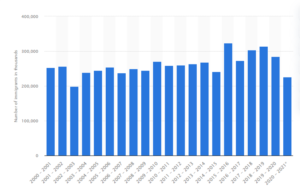In 2022, the Canadian government is looking to immigration as a potential answer as the country begins to recover economically from the consequences of COVID-19. It is never too early to begin the process of immigrating to Canada. There are a number of interesting new developments coming to the country’s immigration system in 2022.
If the pattern that is now occurring does not drastically shift, then the increase in the number of people living in Canada will not be the result of families in Canada having more children. Because of declining fertility rates and increasing average age of the population, it is projected that natural growth, which can be calculated by subtracting births from deaths, would slow down during the next several years. The ratio of number of children to the number of women in Canada is expected to reach a new all-time low in the year 2020 when it is expected to reach 1:4. This natural growth will continue its downward trend over the following several years according to the high growth scenario, and there is a small chance that it could even become negative during the transitional period among 2049 and 2058.
Immigration will be responsible for a significant portion of the population increase that will occur in Canada over the course of the next several decades. There are a number of projections for Canada’s population growth over the next several decades, and all of them include immigration playing a substantial role. This action will continue for the foreseeable future. Over the course of the past year, immigration has continued to add to the expansion of Canada’s population as well as its economy. In 2021, a record number of immigrants will arrive, and ministers have taken stock of the collaborative efforts of the FPT and welcomed and settle nearly 405,000 of them.
Rise in Immigration for Upcoming Years
The objective of the Canadian government on immigration is to sustainably raise the overall amount of immigration in order to boost the country’s economy, bring separated families back together, and aid refugees in need of humanitarian assistance. The economic class, the family class, and the refugee class are the three categories of immigration that Canada accepts. Immigrants who fall into the economic class are those who have been singled out for their potential to make a positive impact on Canada’s economy, whether that be through their own capacity to satisfy the requirements of the labour market, to possess or run a business, to have a significant investment, or to establish their own employment opportunities.
According to the Population Estimates for Canada, Provinces and Territories, 2021 through 2068, the federal government plans to use the average age of immigrants to Canada from 2022 as a method to address the labour deficit, which is a persistent scarcity of young people.
Since the arrival of the first European settlers in the 16th century, Canada has been and still is a popular destination for those seeking to start new lives elsewhere. At the present time, yearly immigration in Canada totals somewhere about 300,000 new residents, making it one of the countries with the greatest rates of immigration relative to its population. Moreover, eight million immigrants who had been granted permanent residency were residing in Canada as of the year 2021; this represented around 21.5 percent of the entire population of Canada. The Canadian public has a divided view on the appropriate level of immigration, with 39% of respondents believing that the number of immigrants should be reduced while 34% expressing contentment with the current level. Even though (or possibly because of) this strong history of immigration in Canada, public opinion is divided.
Immigration laws in Canada
The Immigration as well as Refugee Protection Act, which was passed in 2002, is the major piece of legislation that governs immigration in Canada. According to Canadian immigration law, there are four different types of immigrant admission classes that are included with the family class, which allows individuals or legal residents to sponsor relatives for admission into Canada; this same economic class, which offers an opening to applicants and their close relative who really are likely to contribute to a Canadian economy; this same refugee class, that also provides admission to refugees fleeing persecution and/or torture; as well as the ‘other’ class, which contains immigrants accepted for a variety of other reasons. Persons who moved to Canada for job reasons account for more than twice as many permanent residents as individuals who immigrated mainly for family reasons. Skilled workers make up the single biggest group of immigrants in Canada. In 2021, only about 17 of the total number of immigrants that entered the country were refugees. When looking at refugee arrivals in every class, it was found that over ten thousand were ‘government-assisted.’ This means that the state offers aid to the refugee for up to a year with finding a job, finding housing, obtaining food, and obtaining clothes.

The number of immigrants to Canada has been steadily rising over the previous two decades, with 226,203 persons expected to arrive from July 1, 2020, through June 30, 2021. This number is down from the expected 313,601 immigrants that entered Canada in 2018–2019 but is much over the estimated 199,170 who entered in 2002–2003.
Immigration to Canada by country
According to the results of the most latest census, the nation of origin of persons who were born in Canada to parents from another country was most often India, followed by China. As we look to the future, it is probable that India will continue to strengthen its position, with approximately one-quarter of incoming immigrants to Canada arriving from the nation in 2019.



